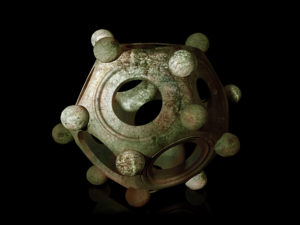Archaeologists tend to be on the frontline of mystery, and regularly pull up many surprises out of the ground, whether these be previously unknown human ancestors, fossils of age-old extinct beasts, or just awe-inspiring treasures that have remained untouched for hundreds or even thousands of years. But when it comes to the excavation of Roman remains, usually there aren’t too many twists. This is because the Roman Empire was one of the biggest and most well-known empires in human history, and source material and general information on this period isn’t scarce. However, there is one particular find from this period in history that continues to stump historians and archaeologists to this day.
The Roman Dodecahedron. Dating from the 2nd– 4th Century CE, this mystery item was first discovered in 1793 and over 100 more have been discovered since. Usually when excavating for Roman remains, one comes across an old bathhouse, maybe some Roman coins with an emperor stamped on them, or if you are lucky, an intact mosaic. But nothing like the Roman Dodecahedron has ever been discovered before, and over 200 years after its discovery, nobody knows what this item was used for.
Made from copper alloy, each Roman Dodecahedron discovered has been cast into a dodecahedral shape that consists of twelve pentagonal shaped sides. Each pentagonal side has a hole of varying size in the middle and five spherical balls sit on the vertices of each pentagonal face. One aspect of the design that baffles historians particularly is the inconsistency in size. The Roman Dodecahedrons vary in size from 4cm-11cm and the circular holes inside the pentagons and spherical balls on the vertices vary in size too. The mystery items have popped up across the range of the former Roman Empire, as far east as Hungary/Romania and as far west as Hadrian’s Wall, on the border of the Roman Empire in Scotland.
The reason that mystery remains around these objects is because they are a relatively contemporary find, and there are no primary sources from the time that discuss their purpose. The Roman Empire is a very well-documented period of history and many technologies from the period were handed down generation to generation years after Roman’s left the lands that the empire had occupied. Various theories have been suggested to explain the purposes of these 12-sided objects. Some suggest that they were used to calculate cosmic and astrological phenomena. The sun may have beamed through the holes on each side and been used to predict when astrological events occurred or when it would be the best time of year to plant crops. Unfortunately, the inconsistency in size of these items throws much doubt on this theory. Another theory argues that the Roman Dodecahedron was used as a decoration, specifically, as a candlestick holder. Some examples that have been found over the last 200 years have shown traces of wax on the surface. It is clear to see that it would be able to hold a candle quite nicely, but these traces of wax may just be evidence of the casting process, which includes the use of wax.
There are two theories that stand out as the most likely to explain the function of the Roman Dodecahedron. The first simply suggests that these items were nothing more than a valuable object to the Romans. Many examples of this mystery item have been discovered in coin hoards. These tend to include coins en masse alongside other items that represented wealth to their owners. It may have also just been a stylized item for wealthy people to exhibit or to wear as an accessory.
The most likely purpose of the Roman Dodecahedron seems serve more purpose than just a sign of wealth though. It may have been a device to aide knitting. Researchers and theorists have been able to prove that it is possible to knit a pair of gloves using the object. You can easily find videos on YouTube of how this can be achieved. This may explain the differences in sizes of the Roman Dodecahedrons and the sizes of the circular holes on them. These different-sized holes would have been for different hand and finger sizes. Most finds have been in the Northern regions of the Roman Empire, and the cold temperatures in these areas support the theory that they may have been used for this purpose.
The knitting theory is most likely the glove that fits when it comes to this mystery. Only time will tell: year by year, archaeological technologies improve, and our understanding and knowledge of the past continues to unfold. However, until historians stumble across a source that discusses the use of a Roman Dodecahedron, or its function can be deduced without a doubt, then scholars and academics will continue to theorize over this 12-sided mystery!
– by James Lapping








